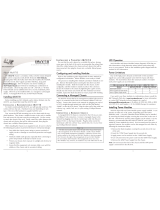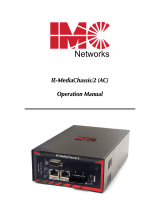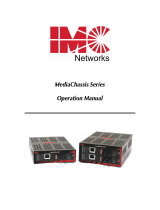Page is loading ...

iMcV-LIM 10/100
Operation Manual

ii
FCC Radio Frequency Interference Statement
This equipment has been tested and found to comply with the limits for a Class B computing device, pursuant to Part 15 of the FCC Rules.
These limits are designed to provide reasonable protection against harmful interference when the equipment is operated in a commercial
environment. This equipment generates, uses and can radiate radio frequency energy and, if not installed and used in accordance with the
instruction manual, may cause harmful interference to radio communications. Operation of this equipment in a residential area is likely to
cause harmful interference in which the user will be required to correct the interference at his own expense.
Any changes or modifications not expressly approved by the manufacturer could void the user’s authority to operate the equipment.
The use of non-shielded I/O cables may not guarantee compliance with FCC RFI limits. This digital apparatus does not exceed the Class B
limits for radio noise emission from digital apparatus set out in the Radio Interference Regulation of the Canadian Department of
Communications.
Le présent appareil numérique n’émet pas de bruits radioélectriques dépassant les limites applicables aux appareils numériques de classe B
prescrites dans le Règlement sur le brouillage radioélectrique publié par le ministère des Communications du Canada.
Warranty
IMC Networks warrants to the original end-user purchaser that this product, EXCLUSIVE OF SOFTWARE, shall be free
from defects in materials and workmanship under normal and proper use in accordance with IMC Networks' instructions
and directions for a period of six (6) years after the original date of purchase. IMC Networks warrants to the original end-
user purchaser that all SFPs shall be free from defects in materials and workmanship under normal and proper use in
accordance with IMC Networks' instructions and directions for a period of one (1) year after the original date of purchase.
This warranty is subject to the limitations set forth below.
At its option, IMC Networks will repair or replace at no charge the product which proves to be defective within such
warranty period. This limited warranty shall not apply if the IMC Networks product has been damaged by unreasonable
use, accident, negligence, service or modification by anyone other than an authorized IMC Networks Service Technician
or by any other causes unrelated to defective materials or workmanship. Any replaced or repaired products or parts carry
a ninety (90) day warranty or the remainder of the initial warranty period, whichever is longer.
To receive in-warranty service, the defective product must be received at IMC Networks no later than the end of the
warranty period. The product must be accompanied by proof of purchase, satisfactory to IMC Networks, denoting
product serial number and purchase date, a written description of the defect and a Return Merchandise Authorization
(RMA) number issued by IMC Networks. No products will be accepted by IMC Networks which do not have an RMA
number. For an RMA number, contact IMC Networks at PHONE: (800) 624-1070 (in the U.S. and Canada) or (949) 465-
3000 or FAX: (949) 465-3020. The end-user shall return the defective product to IMC Networks, freight, customs and
handling charges prepaid. End-user agrees to accept all liability for loss of or damages to the returned product during
shipment. IMC Networks shall repair or replace the returned product, at its option, and return the repaired or new
product to the end-user, freight prepaid, via method to be determined by IMC Networks. IMC Networks shall not be
liable for any costs of procurement of substitute goods, loss of profits, or any incidental, consequential, and/or special
damages of any kind resulting from a breach of any applicable express or implied warranty, breach of any obligation
arising from breach of warranty, or otherwise with respect to the manufacture and sale of any IMC Networks product,
whether or not IMC Networks has been advised of the possibility of such loss or damage.
EXCEPT FOR THE EXPRESS WARRANTY SET FORTH ABOVE, IMC NETWORKS MAKES NO OTHER WARRANTIES,
WHETHER EXPRESS OR IMPLIED, WITH RESPECT TO THIS IMC NETWORKS PRODUCT, INCLUDING WITHOUT
LIMITATION ANY SOFTWARE ASSOCIATED OR INCLUDED. IMC NETWORKS SHALL DISREGARD AND NOT BE
BOUND BY ANY REPRESENTATIONS OR WARRANTIES MADE BY ANY OTHER PERSON, INCLUDING EMPLOYEES,
DISTRIBUTORS, RESELLERS OR DEALERS OF IMC NETWORKS, WHICH ARE INCONSISTENT WITH THE WARRANTY
SET FORTH ABOVE. ALL IMPLIED WARRANTIES INCLUDING THOSE OF MERCHANTABILITY AND FITNESS FOR A
PARTICULAR PURPOSE ARE HEREBY LIMITED TO THE DURATION OF THE EXPRESS WARRANTY STATED ABOVE.
Every reasonable effort has been made to ensure that IMC Networks product manuals and promotional materials
accurately describe IMC Networks product specifications and capabilities at the time of publication. However, because of
ongoing improvements and updating of IMC Networks products, IMC Networks cannot guarantee the accuracy of printed
materials after the date of publication and disclaims liability for changes, errors or omissions.

iii
Table of Contents
FCC Radio Frequency Interference Statement ....................................................ii
Warranty............................................................................................................ii
About the iMcV-LIM 10/100 ..............................................................................1
Configuring Instructions......................................................................................1
Installing an iMcV-LIM 10/100 ...........................................................................1
Modes of Operation...........................................................................................5
Troubleshooting Features ...................................................................................6
LED Operation...................................................................................................7
Specifications.....................................................................................................9
IMC Networks Technical Support.......................................................................9
Fiber Optic Cleaning Guidelines.......................................................................10
Electrostatic Discharge Precautions...................................................................11
Safety Certifications..........................................................................................12

1
About the iMcV-LIM 10/100
The iMcV-LIM is an SNMP-manageable, IEEE 802.3 single-conversion media
conversion module which converts between:
•
10Base-T twisted pair and 10Base-FL multi-mode or single-mode fiber, or
•
100Base-TX twisted pair and 100Base-SX multi-mode fiber, 100Base-FX single-
mode fiber or single-strand single-mode fiber.
The iMcV-LIM requires one slot in an SNMP-manageable chassis or an unmanaged
chassis from IMC Networks. The iMcV-LIM features one RJ-45 connector and one
pair of ST or SC fiber connectors.
Configuring Instructions
The iMcV-LIM has user-configurable features (e.g., FiberAlert (FA), Link Fault
Detection (LFD) and Auto Negotiation (AN). Refer to the iMcV Module DIP Switch
Configuration Table for information on available features. Instructions for configuring
both managed (via an SNMP-compatible management application like iView²) and
unmanaged modules follow.
Installing an iMcV-LIM 10/100
The iMcV Modules install in IMC Networks’ SNMP manageable iMediaChassis series
or in any MediaChassis.
NOTE
All modules are hot-swappable.
To install an iMcV Modules:
1.
Remove the blank bracket covering the slot where the module is to be installed
by removing the screws on the outside edges of the bracket.
2.
Slide the iMcV Modules into the chassis, via the cardguides, until the module is
seated securely in the connector.
3.
Secure the module to the chassis by tightening the captive screw.
4.
Save any “blanks” removed during installation for future use if the configuration
requirements change.

2
Managed Modules
To manage one or more iMcV-LIM(s), an SNMP agent must be present in the chassis.
To configure Managed Modules, install the module first, and then configure using the
management software.
NOTE
Management software overrides any hardware settings (e.g., jumper, switch, etc.); a
module must be configured so that it will be managed via the software. Until a module
installed in a managed chassis is configured via the software, the module (and its LEDs) may
not work properly.

3
Unmanaged Modules
Before installing, configure the iMcV-LIM modules for desired features. Refer to table
which indicates the available features and settings for the iMcV-LIM modules.
After configuring the DIP Switches for the desired settings, install the module and
connect the appropriate cables (refer to the Installating an iMcV-LIM 10/100 section
for more information).

4
Dip Switch Feature Function Default
S1
LFD
Link fault detection available in forced
mode only (S3 is ON)
OFF
S2
AN
Auto Negotiation mode (plug-n-play)
available when forced mode is disabled
(S3 is OFF)
ON
S3
Force
Force mode forces the module to operate
at 10 or 100 Mbps as determined by S4
OFF
S4
10/100
When ON, operates at 10 Mbps.
When OFF, operates at 100 Mbps.
Available when forced mode is enabled
(S3 is ON)
OFF
Remaining DIP Switches are factory configured—DO NOT CHANGE

5
Modes of Operation
The iMcV-LIM allows for three modes of operation:
•
Auto Negotiation (AN) enabled by default
•
Force 10
•
Force 100
The module should be configured for one of these modes.
In Auto Negotiation mode, the module will optimally and automatically configure for
speed (10 or 100 Mbps) depending on the capabilities of the end stations. To enable
Auto Negotiation mode, set switch S2 to the ON position, with switches S3 and S4 in
the OFF position.
In Force 10 mode, the module acts as a 10Base-T to 10Base-FL media converter; 100
Mbps signals are not accepted. To enable Force 10 mode, set switch S3 and S4 to
the ON position, with switch S2 in the OFF position.
In Force 100 mode, the module acts as a 100Base-TX to 100Base-SX multi-mode or
100Base-FX single-mode fiber media converter; 10 Mbps signals are not accepted.
To enable Force 100 mode, set switch S3 to the ON position, with switches S2 and
S4 in the OFF position.

6
Auto Negotiation
When connecting two modules between two end stations (devices such as switches,
hubs and repeaters), all devices should ideally support, and be utilizing, Auto
Negotiation. While it is possible to have Auto Negotiating devices on one side of the
media conversion and fixed (non-Auto Negotiating) devices on the other, link LEDs
will react differently depending on where a link fault occurs.
Troubleshooting Features
The iMcV-LIM includes two advanced troubleshooting features, Transparency and
Link Fault Detection, to help locate “silent failures” on the network.
Transparency
Transparency is only available when using AN. When the iMcV-LIM is Auto
Negotiating, transparency treats the connection between the two end devices as if
there were no media converters installed. For example, in a typical application
where two media converters are installed between two copper-based switches the
twisted pair cables as well as the fiber cable are seen as “one” entity. If a fault occurs
on any segment between the two end devices, link LEDs on the end devices will go
out.
Since transparency is only available when the iMcV-LIM is operating in Auto
Negotiation mode, S2 (AN) must be ON and S1 (LFD), S3 (Force) and S4 (10/100)
must be OFF.
Link Fault Detection
Link Fault Detection (LFD) is only available when using Force 10 or Force 100 mode.
When LFD is enabled and the input link is down at one interface to the iMcV-LIM,
the LFD LED will blink. This applies to both network interfaces and to both data
rates. If the link at the other interface to the iMcV-LIM 10/100 is also down, there is
no output and LFD causes the Link LED to blink.
When the iMcV-LIM is in one of the Force modes, enable LFD by setting S1 to the
ON position. In order for LFD to function properly, Force mode must be enabled by
setting S3 to ON with S4 set for the proper speed.
Twisted Pair Crossover/Pass-Through Switch
The iMcV-LIM features a crossover/pass-through push-button switch, located on the
faceplate next to the RJ-45 connector, to set the twisted pair connection type. Select
a pass-through connection by pressing the push-button IN. A crossover connection is
selected when the push-button is OUT. If it is not clear which connection is needed,
set the push-button to whatever setting makes the twisted pair LNK LED glow.

7
LED Operation
The iMcV-LIM features several diagnostic LEDs per port. The LED functions for the
iMcV-LIM are
LNK
ACT
100
LFD
AN
PWR
100
ACT
LNK
Twisted Pair Port
Glows green when a twisted pair link is established.
Glows yellow when data is detected on the port.
Glows yellow when 100 Mbps data is detected on the
port.
Glows green when Link Fault Detection is enabled.
Glows green when Auto Negotiation mode is enabled.
Glows green when unit has power.
Fiber Port
Glows yellow when 100 Mbps data is detected on the
port.
Glows green when data is detected on the port.
Glows green when a fiber link is established.
NOTE
Before either LNK LED will glow solid, the twisted pair and fiber optic cables must be
connected and the twisted pair crossover/ pass-through switch set correctly.
Link Fault Detection LED Activity
When LFD is enabled and a fault occurs on a segment of the media conversion, the
various Link LEDs in that conversion will either blink or extinguish. LEDs may react
differently depending on the type of end devices in the conversion, whether the
iMcV-LIM is in Force 10 or Force 100 mode, where the fault occurs, etc.

8
Installation Troubleshooting
•
During installation, test the fiber and twisted pair connections with all
troubleshooting features disabled, then enable these features, if desired, just
before final installation. This will reduce the features’ interference with testing.
•
LEDs will only function after both twisted pair and fiber are connected.
•
To test a module by itself, be sure to have an appropriate fiber patch cable, then
follow these steps to test:
Step 1
Connect the media converter to the twisted pair device
with a twisted pair cable. The device must be
configured to force 100FDX.
Step 2
Loop a single strand of fiber from the transmit port to
the receive port of your media converter.
Step 3
Verify that the LNK LED lights for both twisted pair and
fiber link.
WARNING
It is possible to create a network loop if connecting the module’s twisted pair
port to an active network. Be sure to connect the twisted pair cable to a PC
when performing this test.
•
Make sure to use the appropriate twisted pair cable, and have the
crossover/pass-through switch set correctly if a network’s converter does not
include AutoCross.
•
If using a high powered device, which is designed for long distance installations
for a short distance installation, the fiber transmitters may overdrive the receivers
and cause data loss. In such a case, add an optical attenuator to the connection.
Since single-strand fiber products use optics that transmit and receive on two different
wavelengths, single-strand fiber products must be deployed in pairs, or two
compatible IMC Networks single-strand fiber products must be connected. The two
connected products must also have the same speed and distance capabilities (i.e.,
both are single-mode [20km] or both are single/PLUS [40km]).

9
Specifications
Operating Temperature
32° - 104° F (0° - 40° C)
Storage Temperature
20° - 160° F (-20° - 70° C)
Humidity
5 - 95% (non-condensing)
Power Consumption (typical)
650 mA max. @ 5VDC
For fiber optic specifications, visit the IMC Networks Web site.
IMC Networks Technical Support
Tel:
(949) 465-3000 or (800) 624-1070 (in the U.S. and Canada);
+32-16-550880 (Europe)
Fax:
(949) 465-3020
E-Mail:
techsupport@imcnetworks.com
Web:
www.imcnetworks.com

10
Fiber Optic Cleaning Guidelines
Fiber Optic transmitters and receivers are extremely susceptible to contamination by
particles of dirt or dust, which can obstruct the optic path and cause performance
degradation. Good system performance requires clean optics and connector ferrules.
1.
Use fiber patch cords (or connectors, if you terminate your own fiber) only from
a reputable supplier; low-quality components can cause many hard-to-diagnose
problems in an installation.
2.
Dust caps are installed at IMC Networks to ensure factory-clean optical devices.
These protective caps should not be removed until the moment of connecting
the fiber cable to the device. Should it be necessary to disconnect the fiber
device, reinstall the protective dust caps.
3.
Store spare caps in a dust-free environment such as a sealed plastic bag or box
so that when reinstalled they do not introduce any contamination to the optics.
4.
If you suspect that the optics have been contaminated, alternate between
blasting with clean, dry, compressed air and flushing with methanol to remove
particles of dirt.

11
Electrostatic Discharge Precautions
Electrostatic discharge (ESD) can cause damage to any product, add-in modules or
stand alone units, containing electronic components. Always observe the following
precautions when installing or handling these kinds of products
1.
Do not remove unit from its protective packaging until ready to install.
2.
Wear an ESD wrist grounding strap before handling any module or component.
If the wrist strap is not available, maintain grounded contact with the system unit
throughout any procedure requiring ESD protection.
3.
Hold the units by the edges; do not touch the electronic components or gold
connectors.
4.
After removal, always place the boards on a grounded, static-free surface, ESD
pad or in a proper ESD bag. Do not slide the modules or stand alone units over
any surface.
WARNING!
Integrated circuits and fiber optic components are
extremely susceptible to electrostatic discharge damage. Do not
handle these components directly unless you are a qualified service
technician and use tools and techniques that conform to accepted
industry practices.

12
Safety Certifications
CE: The products described herein comply with the Council Directive
on Electromagnetic Compatibility (89/336/EEC) For further details,
contact IMC Networks.
European Directive 2002/96/EC (WEEE) requires that any equipment that bears this
symbol on product or packaging must not be disposed of with unsorted municipal
waste. This symbol indicates that the equipment should be disposed of separately
from regular household waste. It is the consumer’s responsibility to dispose of this
and all equipment so marked through designated collection facilities appointed by
government or local authorities. Following these steps through proper disposal and
recycling will help prevent potential negative consequences to the environment and
human health. For more detailed information about proper disposal, please contact
local authorities, waste disposal services, or the point of purchase for this equipment.
Class 1 Laser product, Luokan 1 Laserlaite,
Laser Klasse 1, Appareil A’Laser de Classe 1

19772 Pauling • Foothill Ranch, CA 92610-2611 USA
TEL: (949) 465-3000 • FAX: (949) 465-3020
www.imcnetworks.com
© 2009 IMC Networks. All rights reserved.
The information in this document is subject to change without notice. IMC Networks assumes no responsibility for any
errors that may appear in this document. iMcV-LIM 10/100 is a trademark of IMC Networks. Other brands or product
names may be trademarks and are the property of their respective companies.
Document Number 50-80216-01 B5 September 2009
/







